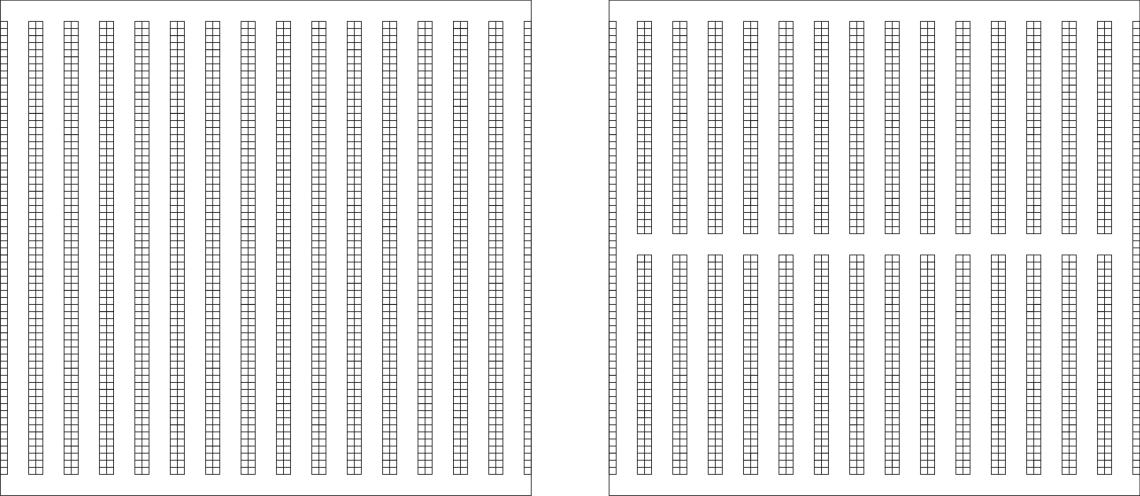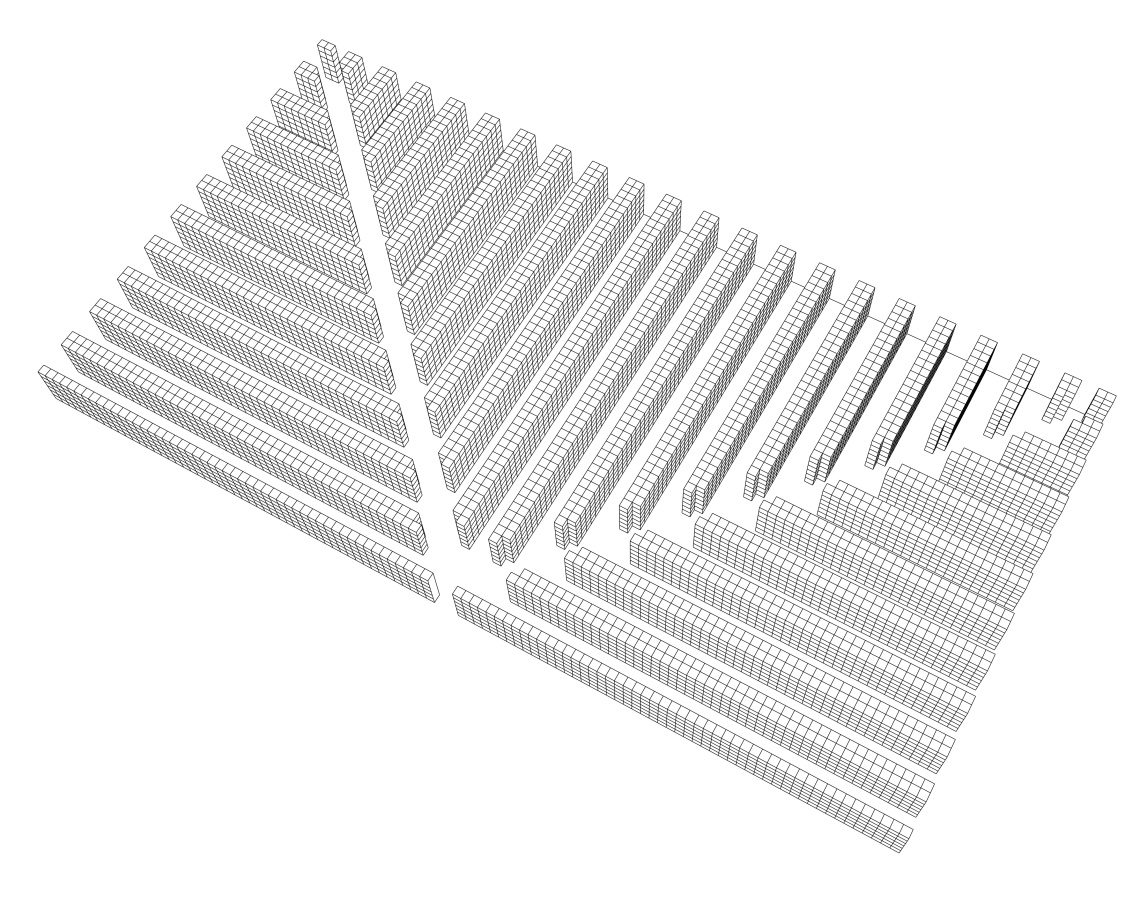In a traditional warehouse, storage racks are arranged to create parallel picking aisles, perhaps with one or more cross aisles to allow workers to move quickly between picking aisles. This structure forces workers to travel rectilinear distances (north-south and east-west) to picking locations.
The traditional design is based on a number of unspoken, and unnecessary, assumptions. Why, for example, must cross aisles meet picking aisles at right angles? Or why do picking aisles have to be parallel? The answer, of course, is that they do not, and our research shows that adhering to these assumptions could result in a significant penalty in labor costs.
We consider the problem of arranging picking aisles and cross aisles in new ways to reduce the cost of travel within warehouses. Our models produce alternative designs that promise to reduce travel distances in a reasonably-sized warehouse by more than 20 percent (for some operations). Below is an example that maintains parallel picking aisles, but allows the cross aisle to take on a different shape. We call this the “Flying V”. If travel begins and ends at the bottom of the V, the expected distance to retrieve a single pallet is 10% less in this warehouse than in an equivalent traditional design.
Travel in a Flying-V is along 3 possible paths. Workers can–and should–travel rectilinear paths to locations near the bottom of warehouse; they use the cross aisle to access both locations above the cross aisle and locations slightly below it. Notice that travel to items below the cross aisle seems less efficient than to items above it. To address this, we relax a second unspoken assumption–that picking aisles must be parallel. We call this the fishbone design.
For a demonstration of the benefit of these designs (and some music), check out this video:
The Chevron design has a single, vertical cross aisle and picking aisles at angles 45 and 135 degrees. As with the Fishbone design, the idea is to allow workers to take “straight line paths” to locations as closely as possible.

The Leaf design is similar to the Fishbone in that it has two cross aisle segments, but we have relaxed the requirement that picking aisles be vertical or horizontal. Cross aisles in the Leaf design are steeper than in a Fishbone design, and picking aisles on the right and left sides are at an angle that reduces expected travel.

Notice that the Leaf requires more space around the pickup & deposit (P&D) point at the bottom, which is a disadvantage of the design because the otherwise best locations are displaced. This phenomenon is even more notable in the Butterfly:

So, there is a tradeoff: increasing the number of cross aisles makes travel nearer and nearer to direct “travel-by-flight,” but at the cost of displacing the locations nearest the P&D point. When is it no longer beneficial to add additional cross aisles?
Below is a plot that partially answers that question. The Chevron design has the lowest expected travel distance (highest percent improvement over a traditional design) when the number of aisles in an equivalent traditional design is 27 or fewer. For warehouses between 29 and 63 aisles, the Leaf design is slightly better than Chevron. For warehouses greater than 65 aisles, the Butterfly is ever-so slightly better than Leaf.
These observations lead us to conclude that for operations conforming to our main assumptions the Chevron is the best design for warehouses of realistic size.





Do you think boundary pallet conveyors could be a practical method of reducing return travel time with the Chevron aisle design?
Not sure exactly what you mean by “boundary pallet conveyors,” but nothing about these layouts prohibits the use of automation. The obstacle, of course, would be justifying the cost.
When applying the new design on a traditional warehouse to know if it’s effective or not
We need to compare the cost of travel after implementing the new design
To the value of each of the storage untie lost due to the implementing of the new design
How can we calculate the worth/value of each storage unite lost to justify that the new design is efficient?
This tradeoff is discussed in the paper, which you can find on my publications page.
Hey, very interesting article. I’m doing a project for my BS.c degree in industrial engineering on warehouse design, and im interested to know what program did you use in the video, it will help me alot, thanks.
The video was done by a student at Arkansas, using Flash directly.
Hello Kevin, remarkable ideas and efforts. But being an I.E, I also must consider the ratio between aisle area (sq. ft.) and material covered area (sq ft.). Apparently it seems that some area for material is sacrificed in these aisles’ models. Is there any details about you have to share that how much area is reduced against increasing the traveling efficiency?
Thank you and God bless you.
The papers give details on loss of space. The fishbone design has about 5-10% fewer locations in a reasonably sized warehouse. The chevron is more space efficient because there is only one cross aisle. Ozturkoglu et al. (2012) has the plots of lost space.
What if the design of the warehouse has the loading/unloading dock in a particular corner? I’ve played with your design a little trying to find the most efficient way to apply it but haven’t had any luck. If it were applied as is, what would be your suggestion on the improved efficiency with our home point being moved to that area?
If your I/O point is in the corner, the best design is probably a “half fishbone,” in which the cross aisle extends from the I/O point to the opposite corner of the warehouse. Picking aisles should be 45 degrees offset from the cross aisle. But please email or call before you do anything! I’d be happy to chat about the details.
If your warehouse exist of pickfaces on the ground location racking and bulk locations on top of that, 2 types of material handling equipment will cross each other in these fishbone aisles. What you suggestion to optimize the crossing traffic knowing that the task from pickfaces have multiple picks in 1 run from different locations where the reach trucks only have 1 task per run.
These designs (fishbone, chevron, etc.) are intended for unit-load operations only, not for order picking. We are about to release some results for aisle designs for order picking warehouses.
However, you raise a very interesting question that I had never considered: What if, as you describe, order picking and unit-load operations are happening in the same warehouse? I cannot say what a good design looks like for this case, but the tools we are currently building will be able to answer this question. We’ll put it on the list!
Thanks for the quick response. I am looking forward to the results of these models.
I’m wondering what to do if you want to expand the capacity of an existing fishbone warehouse. I can imagine that the advantages over a traditional layout will reduce in that case, because the expansion possibilities are more limited than those for the traditional layout and you cannot easily alter the fishbone layout anymore (increment between two lines for example).
Good point!
Excellent article, Kevin.